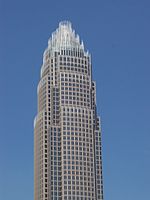
The Bank of America Plaza is a skyscraper located in Downtown St. Louis, Missouri. Formerly Boatmen's Bancshares of St. Louis and First National Bank, the tower is 384 ft (117m) tall and has 31 floors.[citation needed] Built in 1982 by Fruin-Colnon Construction, it comprises 750,000 square feet (70,000 m2), and has a view of the downtown skyline. It is the fourth largest office building in Downtown St. Louis.[1]
The building won the Building Owners and Managers Association (BOMA) “Building of the Year” awards for the years 1996 through 1999.
Ralcorp and subsidiary Post Foods have their headquarters in the building.[2][3] In 2003, Bank of America was the largest tenant in the building and had nearly 500,000 square feet (46,000 m2) of space. During that year PricewaterhouseCoopers leased space in the Bank of America Plaza, which was 96% occupied.[1]
History
[edit]In 2003 the General Electric Pension Trust, the owner of the Bank of America Plaza, offered to sell the building.[1] In August 2014, part of the staff of Laclede Group was moved to the building.[4]
See also
[edit]References
[edit]- ^ a b c Jackson, Margaret. "Bank of America Plaza placed on market." St. Louis Business Journal. Friday July 25, 2003. Retrieved on January 18, 2010.
- ^ "Contact Us Archived 2010-01-05 at the Wayback Machine." Post Foods. Retrieved on January 18, 2010.
- ^ "Contact Us Archived 2010-01-13 at the Wayback Machine." Ralcorp. Retrieved on January 18, 2010.
- ^ Kirn, Jacob (25 August 2014). "Laclede Group to move some employees to Bank of America Plaza". St. Louis Business Journal. Retrieved 30 March 2015.
External links
[edit]38°37′33″N 90°11′38″W / 38.6259°N 90.1940°W

Well, that’s interesting to know that Psilotum nudum are known as whisk ferns. Psilotum nudum is the commoner species of the two. While the P. flaccidum is a rare species and is found in the tropical islands. Both the species are usually epiphytic in habit and grow upon tree ferns. These species may also be terrestrial and grow in humus or in the crevices of the rocks.
View the detailed Guide of Psilotum nudum: Detailed Study Of Psilotum Nudum (Whisk Fern), Classification, Anatomy, Reproduction